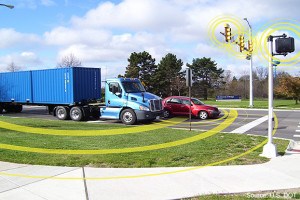Wyoming is one of three locations in the country where next-generation “smart vehicles” that could make highway driving less dangerous will be tested.
The U.S. Department of Transportation this week announced Wyoming will participate in the Connected Vehicle Pilot Deployment Program.
Wyoming, New York City and Tampa, Florida, will share up to $42 million to use “innovative applications” for vehicles that share and communicate anonymous information with each other and their surroundings.

The exact amount Wyoming will get is unknown. But Vince Garcia, a program manager with the Wyoming Department of Transportation, said the agency estimated in its application it would need “in the ballpark” of $5 million.
Wyoming’s part in the program will be targeted at improving freight traffic flows through the Interstate 80 corridor.
Ali Ragan, another project manager with WYDOT, tells the Wyoming Tribune Eagle that it is too early to say what technology will be used and how many vehicles will be in the program.
But she said some possibilities include letting truckers know through their phones, in-vehicle GPS units or other methods whether there are high-wind warnings, construction or other dangers ahead.
“Anyone who drives on I-80 knows that there is a lot of truck traffic, and that traffic can really impact safety,” she said. “We want to have information to create safer traveling conditions and to improve safety for everyone.”
Vehicle-to-vehicle communications also could be used to “harmonize” the speed among drivers by sending speed recommendations based on road conditions and level of congestion ahead.
Ragan added that passenger vehicles could be incorporated in the program.
Participation in the program would be voluntary. But Ragan said the Wyoming Trucking Association is supporting the project and several trucking firms have expressed interest.
Garcia said data-collection units on the vehicles also could send information back to WYDOT workers or first responders to let them know instantly about dangerous road conditions or vehicle crashes.
“We could even use vehicle sensors by letting us know when windshield wipers or things like anti-lock brakes are triggered,”
Ragan said the state’s program will take about a year to get off the ground. The development and demonstration phases will then occur over the following three years.
WYDOT officials expect to learn more about specific provisions in the coming weeks.
While Wyoming will focus on the rural parts of the country, the two other locations will see how so-called “smart vehicles” work in more populated areas.
According to the U.S. Department of Transportation, research has shown that this type of technology can reduce unimpaired vehicle crashes by 80 percent and reduce the billions of hours that Americans spend in traffic each year.
The National Highway Transportation Safety Association is expected to issue a proposed rule by the end of the year to eventually require all new vehicles to come equipped with vehicle-to-vehicle communication equipment.
Was this article valuable?
Here are more articles you may enjoy.

 Oregon Schools Sued for $9M After Young Girl Allegedly Raped
Oregon Schools Sued for $9M After Young Girl Allegedly Raped  Hawaiian Electric Hits 40-Year Low Ahead of Maui Fire Report
Hawaiian Electric Hits 40-Year Low Ahead of Maui Fire Report  Property Restoration Industry: A Culture in Need of Repair?
Property Restoration Industry: A Culture in Need of Repair?  Dog-Related Injury Claim Payouts Hit $1.12B in 2023, Report Shows
Dog-Related Injury Claim Payouts Hit $1.12B in 2023, Report Shows 